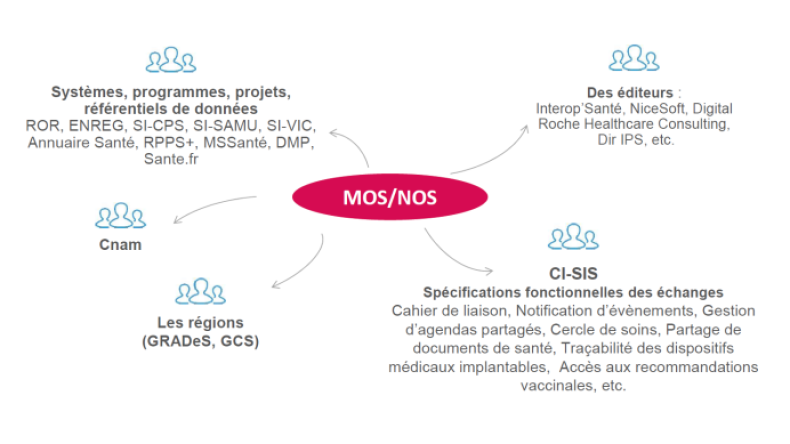Votre question concerne quel type d'offre ?
Votre question concerne quel couloir Ségur ?
Votre question concerne quel dispositif Ségur ?
Votre question concerne quel produit ou service produit?
Votre question concerne quelle thématique ?
All the rules are set out in the HDS certification – Accreditation reference system and the COFRAC’s "Exigences spécifiques pour l’accréditation des organismes procédant à la certification de systèmes de management dans le domaine des technologies de l’information" (Specific requirements for structures that certify management systems in the information technology sector), available in our Documentation section.
To find out more about the list of certified and accredited bodies, click on the links below.
Cette réponse vous a-t-elle été utile ?
There are 6 types of activities that make you eligible as a health data host:
- providing and monitoring the operations of a physical site that hosts the material infrastructure of the IS used to treat health data;
- providing and maintaining the structural material used by the IS to host health data;
- providing and maintaining a platform that hosts the IS applications;
- providing and maintaining a digital structure for the IS which hosts health data;
- the administration and exploitation of the IS which contains the health data;
- health data backup services.
The full list of HDS-certified activities is available here:
Cette réponse vous a-t-elle été utile ?
Le Centre de Gestion des Terminologies de Santé a donc pour mission de se charger de cette maîtrise d’ouvrage opérationnelle des ressources sémantiques, mais aussi du guichet national de publication, ainsi que de l’accompagnement des utilisateurs. En France, le CGTS regroupe à date au sein de son catalogue 34 Terminologies couvrant un grand nombre de domaines médicaux.
Cette réponse vous a-t-elle été utile ?
The list of connected services is available online.
Cette réponse vous a-t-elle été utile ?
Guarantees are set out on the dedicated page.
Cette réponse vous a-t-elle été utile ?
The evaluation is done in two phases. It is conducted by the certifying body, which must verify the compliance with the certification requirements set out in the HDS Certification document (available below).
The audit also verifies the specific requirements for health data hosting are being met.
Cette réponse vous a-t-elle été utile ?
Health professionals are encouraged to use MOS and NOS for three main reasons :
- enhance the interoperability of information systems by harmonising names, attributes, codes and nomenclatures;
- share the same understanding of the information, regardless of which directory or reference document it is taken from;
- facilitate the specification, analysis and conception of a project.
The ANS offers training on MOS-NOS and the elaboration method for exchanges’ functional specs (see our Documentation section).
The illustration below gives you examples of the types of professionals using the MOS-NOS:

Cette réponse vous a-t-elle été utile ?
A terminology is an ensemble of concepts defined by terms which belong to a specific language set.
Terminologies are defined through a research process aimed at finding the most relevant terms used by a specific profession (or a field of expertise) in a particular context of use.
Centralising and monitoring this vocabulary is essential to maintain a coherent use of the terms amongst eHealth experts and healthcare professionals.

Cette réponse vous a-t-elle été utile ?
The MOS is a collection of concepts described homogeneously and neutrally in terms of technologies. It offers a common description of the information processed and exchanged in the information systems to make digital communication easier.
The overall consistency of the MOS is founded on the definition and description of its UML (Unified Modelling Language) concepts.
Some MOS concepts can be coded. They are associated with the nomenclatures of health objects (NOS), i.e. lists of codes/labels.
You are encouraged to use MOS and NOS to :
- optimise and coordinate efforts when you analyse or conceive a system (or an application) by re-using the same semantic components;
- make sure there is consistency in your internal developments and with external systems, for the best possible interoperability.
Cette réponse vous a-t-elle été utile ?
The digital transition in France involves much more health data transfers. It is essential to set up a common language in this ecosystem, which currently lacks homogeneity at a local and international scale. The CGTS was created by the State to centralise the semantic resources for health professionals.
Cette réponse vous a-t-elle été utile ?
The European Commission’s studies have determined there is a need for a base vocabulary, such as MOS and NOS, which can be used as a starting point for:
- develop and evolve information systems (IS) to formalise the conceptual and logical data they utilise (for instance, the MOS is a reference for the modelling of the RPPS);
- share information between ISs to create specific models of data they can use (thus, the MOS is underlying the ROR exposure model);
- combine and synthetise elements originating from different sources;
- publish data in a common format, such as a directory or catalogue of service (for example, the Annuaire Santé / Health Pro Directory).
Cette réponse vous a-t-elle été utile ?
There are several levels of requirements for a module’s integration into the Hospital Information System.
The main requirements set out by the referential are:
- Interfacing, control, security guidelines;
- Prescription process requirements;
- National prescription thesaurus integration requirements;
- Requirements regarding medico-economic and decision processes;
- Guidelines for ergonomics, functions, and notification alerts;
- Settings function requirements.
In total, 139 requirements are used to reach the minimal level of security needed for a solution’s integration into the hospital information system.
Cette réponse vous a-t-elle été utile ?
The current referential (2017) was written with industry experts. It introduces the particular context of this mission and the goals to reach in order to improve safety measures in neonatology and paediatric reanimation. The referential walks you through the fundamental concepts you need to grasp to understand the several requirements and protocols involved with software development for this sector.
Cette réponse vous a-t-elle été utile ?
Neonatology is a high-risk practice for two main reasons:
- The patients are extremely fragile (premature babies)
- 50% of the drugs used in the sector have yet to receive a marketing authorisation.
A survey conducted in 2014 evidenced a risk in the prescription process across the sector. The digitalisation of prescription is among the 41 recommendations that the report issued in order to increase safety levels.
Cette réponse vous a-t-elle été utile ?


